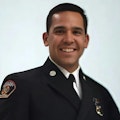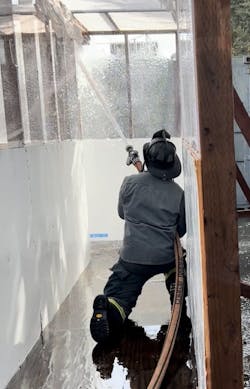The 3 C's of Compartment Firefighting
Key Highlights
- When operating on the interior of a structure fire, it’s helpful to break the structure down into boxes, or compartments. This allows members who are carrying out interior attack to concentrate on the space that they're in and to be very deliberate with their water, to control that space before advancing to the next.
- Body positioning, angle of approach and stream usage are imperative when working to keep the fire confined to a compartment(s).
- The "clean" component of the 3 C's of compartment firefighting calls for wetting all surfaces and ensuring base extinguishment.
The importance of engine companies effectively estimating the stretch, deploying a hoseline and managing it from the threshold of the front door to the fire compartment, all while deliberately applying water, can’t be overstated. The engine company often is viewed as the backbone of the fire service for a reason: Engine companies’ primary mission is to place a line between the fire and potential victims/searchable space. It is, in a sense, the very essence of our being: stopping fire progression and giving any potentially trapped occupants the best chance of survival.
Often, those who are passionate about engine work are met with resistance, such as, “I get it. Water puts out fire. It isn’t that difficult. It’s basic.” Theoretically speaking, they aren’t wrong. Fireground operations can be broken down into a series of basic, yet essential, skills that are packaged together and performed simultaneously.
We can break down fire attack the same way while operating on the interior, by focusing on one compartment at a time and concentrating on our ability to control, confine and clean the compartment(s).
Where fights on the fireground are won or lost
I often am asked, “If you had one full day to deliver a class to a group of firefighters, no matter what their experience level or rank, what would you focus on?” My reply always has been the same: the push.
The push encompasses everything from the threshold of the front door or entry point to the seat of the fire and everything that’s in between. This is where fights on the fireground are won or lost and where the engine company earns its credibility.
I want to make it clear that this is in no way meant to devalue the importance of the stretch. The push doesn’t happen without the stretch. Nor is it meant to take away from the importance of knowing how to operate within the fire compartment. The emphasis on the push stems from the many variables that must be accounted for during it and who typically is on the hoseline. The importance of having a well-trained, proficient firefighter on the nozzle can’t be overstated. Often, firefighters who are on the nozzle are the least senior members of crews, which means that they most likely have the least number of slide shows in their head and lack the intimate knowledge that’s needed to identify the signs of winning or losing on the interior.
If we tailor instruction to the heart of the push—the one part of the overall attack that has the most variables—we can at least build a foundation for the nozzleperson to expand upon. This is where the 3 Cs come into play. When paired with Lt. Ray McCormack’s “3 Cs of Suppression” (coverage, cooling and contraction), it creates a system that’s aimed at maximizing the effectiveness of our push.
Control
The first component is our ability to control the compartment that we are in as we move to the next.
When operating on the interior, it’s helpful to break the structure down into boxes, or compartments. This allows us to concentrate on the space that we are in and to be very deliberate with our water, to control that space before advancing to the next.
Control is the component that carries some subjectivity, simply because its definition can vary from person to person. What one firefighter feels comfortable leaving behind, another might not. A simple question that you can ask yourself to gauge whether the compartment is controlled is, “Would I feel comfortable leaving a victim in that compartment?” If the answer is yes, then you should feel comfortable calling it controlled. That means that you effectively cooled the space and sealed off the compartment as the nozzle advances forward through temperature reduction, gas contraction and flow path reversal.
We must approach each compartment, whether it’s the living room, kitchen, hallway, bedroom, etc., with the mindset “I don’t want to just cool it; I want to control it, so that I can leave it and not worry about it.”
Confine
As we move from compartment to compartment and seal off everything that’s behind the nozzle, our ultimate goal is to get early water into the compartment(s) that’s fueling the problem: the seat. You’re earning yourself a chance to be chest-up to the problem and to experience the satisfaction of getting the knock. If it’s one compartment that’s going, keep it to one. If it’s two, keep it to two. The goal is to hit the problem early, shove back into the compartment, and confine it there.
Body positioning, angle of approach and stream usage are imperative when working to keep the fire confined. This is why the emphasis must be on the push when training in engine company operations.
Clean
I often get confused looks when I ask what people think that I mean by “cleaning the compartment.” Well, it’s exactly what it sounds like. You’re going to wash down the entire compartment: Wet all surfaces and ensure that you get base extinguishment. That said, once you removed the heat problem, the room still is “dirty,” and you must address a secondary issue: the smoke.
You have two options: You can call for a vertical ventilation hole, or you can take ownership of the compartment and initiate horizontal ventilation, which is severely undervalued.
If the compartment required a flow-and-move approach, the window that’s in the room already might be taken. If not, it most likely is weakened severely. Bring the stream down to about chest height and run it laterally across the walls; you might end up taking that weakened window.
Another option is the use of an outside vent man or having your backup enter the compartment to take it.
The final step in cleaning the compartment is the most important: search. Wipe down the room with your hands, figuratively speaking, and complete a primary search. You now gave any possible life inside the absolute best chance of survival.
Ownership and accountability
The engine company must take ownership of its essential tasks and hold itself accountable, not only to the standard that the fire service set but to the standard and expectations that the public set. The latter is clear: Show up quickly, put the fire out and rescue anyone who’s inside. This approach and the essential skills that are associated with it are basic, but there’s beauty in the basics. Focus on the essentials, simplify tasks and remember, you are there for them.
About the Author

Rick Archuleta
Rick Archuleta is the owner and lead instructor of Reliant Fire Training. With more than 12 years of experience in the fire service, he currently serves as a firefighter with the Clovis, CA, Fire Department. A state certified instructor, Archuleta has developed a passion for engine company operations, search and fire behavior. He contributes to his department as a member of the multicompany operations, firefighter survival and recruit academy cadres. Archuleta has spent seven years as an instructor for California State Firefighter 1 Academies. He holds an associate degree in fire technology and is pursuing a bachelor’s degree in fire administration from Columbia Southern University.
